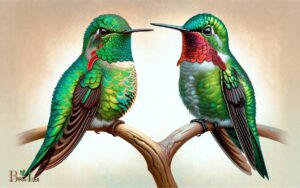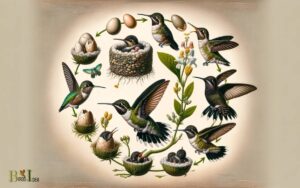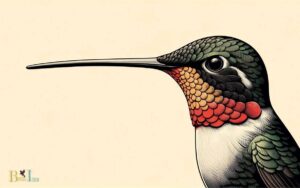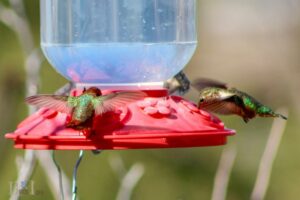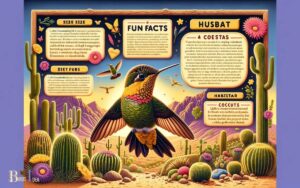Ruby Throated Hummingbird at Feeder: Fascinating!
The Ruby-throated Hummingbird, a jewel among garden visitors, is often seen flitting around feeders filled with sugar water.
These vibrant birds, recognizable by their iridescent emerald feathers and the ruby-red throat patch displayed by males, are a delightful sight for birdwatchers.
To attract them, ensure your feeder is clean, filled with a mixture of one part sugar to four parts water, and placed in a location safe from predators.
The Ruby-throated Hummingbird (Archilochus colubris) is the most widespread hummingbird in North America. It’s important for those looking to attract these birds to understand their feeding habits and preferences.
Here’s a brief overview:
Witnessing the acrobatic flight of the Ruby-throated Hummingbird at your feeder can transform your garden into a lively sanctuary filled with natural wonder and beauty.
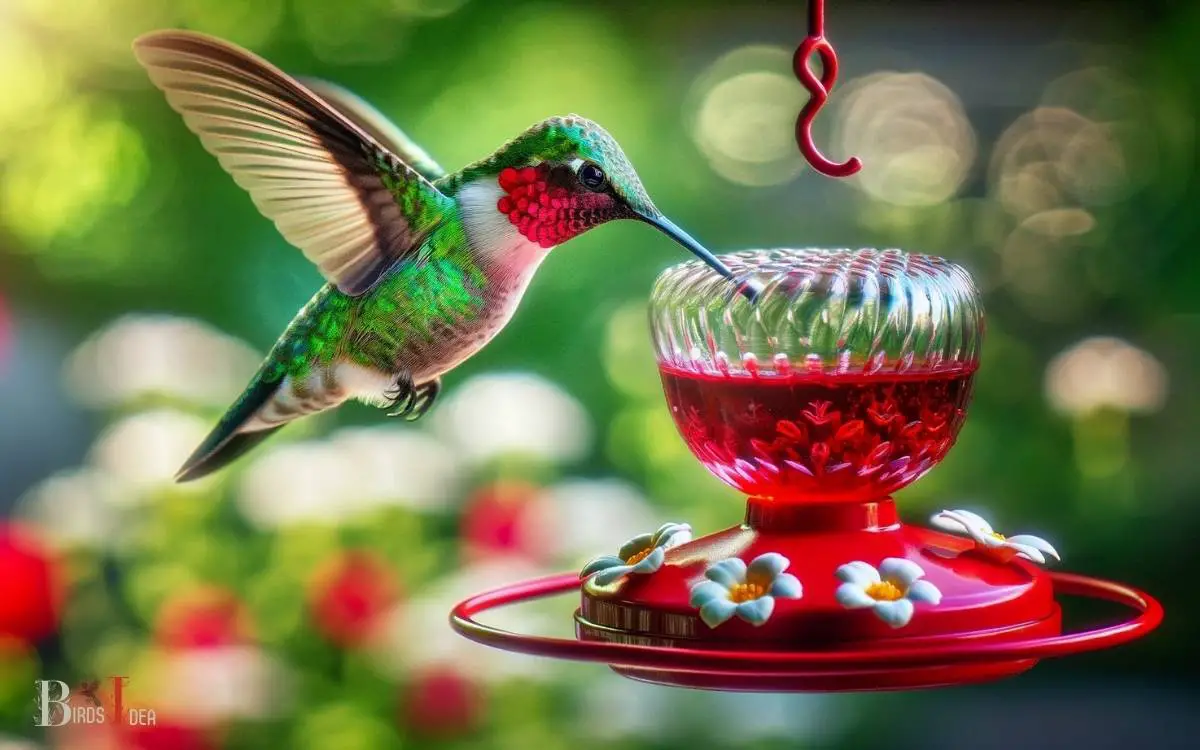
Key Takeaway
The Ruby Throated Hummingbird: An Introduction
The Ruby Throated Hummingbird embodies elegance and resilience in its natural habitat. This stunning creature is known for its vibrant red throat patch, iridescent green feathers, and remarkable agility.
Measuring a mere 3-3.5 inches in length and weighing only a few grams, this species is a wonder of nature.
Found primarily in the eastern United States and Canada, these birds undertake an incredible migration across the Gulf of Mexico every year.
Their rapid wing beats, sometimes exceeding 50 per second, allow them to hover in mid-air and move with exceptional precision.
With a diet primarily consisting of flower nectar and small insects, the Ruby Throated Hummingbird plays a crucial role in pollination.
Understanding their natural behaviors and preferences is vital for creating an environment that supports their well-being and sustains their populations.
This includes providing suitable feeders and ideal placement to attract and support these remarkable birds.
Feeder Preferences and Placement
When considering feeder preferences and placement, it is essential to identify ideal locations that provide both access to food and safety from potential predators.
Additionally, understanding the specific dietary needs and behaviors of different bird species can help in attracting and maintaining a diverse array of visitors.
Finally, regular feeder maintenance, such as cleaning and refilling, is crucial for ensuring the health and well-being of the birds that frequent the feeder area.
Ideal Feeder Locations
Selecting an optimal location for hummingbird feeders involves considering factors such as sunlight exposure, proximity to cover, and lack of disturbance.
Hummingbirds are attracted to feeders placed in areas that provide some protection from the sun during the hottest parts of the day. They also prefer locations near trees or shrubs where they can perch and survey their surroundings before feeding.
Additionally, avoiding high-traffic areas or places where pets or other animals may cause disturbances is crucial for attracting hummingbirds to feeders.
To create an ideal environment for these delicate creatures, consider the following feeder placement tips:
- Choose a location with dappled sunlight to provide shade and warmth.
- Place feeders near natural cover, such as trees or bushes, for perching and protection.
- Minimize disturbances by avoiding high-traffic areas.
- Keep feeders out of reach of potential predators to create a safe feeding environment.
Attracting Specific Bird Species
To attract specific bird species like the Ruby Throated Hummingbird to feeders, it is important to carefully consider ideal feeder placement based on factors such as sunlight exposure, proximity to cover, and disturbance levels, as discussed in the previous subtopic.
Ruby Throated Hummingbirds are attracted to feeders placed in areas with partial sunlight, as excessive sunlight can cause nectar to spoil more quickly.
Additionally, positioning feeders near trees or shrubs provides resting places for these tiny birds and offers protection from predators.
Minimizing disturbances, such as loud noises or sudden movements, is crucial for encouraging these skittish birds to frequent feeders.
Understanding the preferences of specific bird species and optimizing feeder placement accordingly can greatly enhance the likelihood of attracting and observing these delightful creatures in your outdoor space.
Feeder Maintenance Tips
Feeder maintenance for attracting Ruby Throated Hummingbirds involves carefully positioning feeders to optimize sunlight exposure, proximity to cover, and minimizing disturbances.
- Sunlight: Place feeders where they receive morning sunlight and are shaded during the hottest part of the day.
- Proximity to cover: Position feeders within 10-15 feet of trees or shrubs to provide perches and escape routes.
- Minimize disturbances: Keep feeders away from high-traffic areas to reduce human and pet disturbances.
- Height: Hang feeders at a height of 5-10 feet to prevent easy access for predators.
Following these maintenance tips will create an environment that is attractive and safe for Ruby Throated Hummingbirds. Next, we will explore techniques for attracting these captivating birds to your yard.
Attracting Hummingbirds to Your Yard
Attract hummingbirds to your yard by planting a variety of nectar-rich flowers and providing a clean water source.
Hummingbirds are attracted to vibrant, tubular flowers such as bee balm, trumpet vine, and salvia. These flowers provide the nectar that hummingbirds need for energy.
Additionally, incorporating a clean water source, such as a birdbath or a mister, can further entice these beautiful creatures to visit your yard. Observing hummingbirds in your own outdoor space can be a rewarding experience.
The following table provides a list of nectar-rich flowers that are known to attract hummingbirds:
| Flower | Color | Blooming Season |
|---|---|---|
| Bee Balm | Red, Pink | Summer |
| Trumpet Vine | Orange, Red | Summer-Fall |
| Salvia | Red, Pink | Spring-Summer |
Feeder Maintenance and Hygiene
Feeder maintenance and hygiene are crucial for attracting and keeping hummingbirds healthy and returning to your yard.
Regularly cleaning feeders with a 10% bleach solution and thoroughly rinsing them can prevent the build-up of mold and harmful bacteria, ensuring a safe feeding environment for the birds.
Additionally, inspecting feeders for any signs of wear and tear and replacing them when necessary will further contribute to the health and well-being of the visiting hummingbirds.
Clean Feeders Regularly
Regularly cleaning feeders is essential for maintaining a healthy environment for visiting hummingbirds. Keeping the feeders clean helps prevent the growth of harmful bacteria and fungi, ensuring the well-being of these delicate creatures.
Here are some key reasons why regular feeder maintenance is crucial:
- Preventing Disease: Clean feeders reduce the risk of spreading avian diseases, promoting the overall health of the hummingbird population.
- Attracting More Birds: A clean feeder is more appealing to hummingbirds, increasing the likelihood of frequent visits and enhancing the birdwatching experience.
- Preserving Nectar Quality: Regular cleaning prevents nectar spoilage, ensuring that the hummingbirds have access to fresh, uncontaminated food.
- Environmental Responsibility: By maintaining clean feeders, you contribute to the conservation of these fascinating and beautiful creatures.
Prevent Mold and Bacteria
To maintain a healthy environment for visiting hummingbirds, it is essential to prevent mold and bacteria through meticulous feeder maintenance and hygiene.
Mold and bacteria can quickly develop in hummingbird feeders, potentially harming the delicate birds that rely on them for sustenance. To prevent these issues, it is crucial to regularly clean and disinfect feeders.
The use of specialized cleaning brushes and mild, unscented dish soap can help remove any build-up of mold or bacteria.
Additionally, it is important to rinse the feeders thoroughly and allow them to dry completely before refilling them with fresh nectar.
Ensuring that the nectar is changed every few days, especially in warm weather, can also aid in preventing the growth of harmful microorganisms.
By following these maintenance and hygiene practices, hummingbird enthusiasts can provide a safe and healthy environment for these captivating birds.
Understanding Hummingbird Behavior
The behavior of the Ruby Throated Hummingbird at the feeder provides valuable insights into the complex and fascinating world of hummingbird behavior.
Observing these tiny creatures can reveal the following:
- Territorial Displays: Male hummingbirds often engage in aerial displays to defend their feeding territory, showcasing their vibrant plumage and agility.
- Feeding Frenzy: When a hummingbird feeder is well-stocked with fresh nectar, a flurry of activity ensues as multiple birds visit the feeder, displaying their competitive nature.
- Courtship Rituals: During mating season, males perform elaborate aerial dances and vocalizations to attract females, illustrating the intricacies of their courtship behavior.
- Spirited Chases: Hummingbirds engage in high-speed chases, demonstrating their determination to establish dominance and protect their resources.
Understanding these behaviors offers a glimpse into the captivating and dynamic lives of these remarkable birds.
Conservation and Supportive Practices
Implementing supportive practices for the conservation of Ruby Throated Hummingbirds begins with understanding their habitat needs and promoting biodiversity. These hummingbirds rely on diverse nectar sources, insects, and sheltered nesting sites.
To support their conservation, it is crucial to cultivate native flowering plants, such as trumpet vine, bee balm, and cardinal flower, which provide essential nectar for these tiny birds.
Additionally, minimizing pesticide use and creating a favorable habitat with a variety of plant species can enhance foraging opportunities and nesting options.
Supportive practices also include raising awareness about the threats these hummingbirds face, such as habitat loss and climate change.
Through these efforts, we can contribute to the preservation of the Ruby Throated Hummingbird and its ecosystem, ensuring the continued presence of this remarkable species for future generations.
Conclusion
The ruby-throated hummingbird is a fascinating creature to observe and study. Its behavior and feeding preferences provide insight into the delicate balance of nature.
As we strive to attract and support these beautiful birds in our yards, we must also be mindful of the impact of human activity on their habitats.
It is ironic that while we seek to bring them closer to us, our actions may inadvertently threaten their survival.


